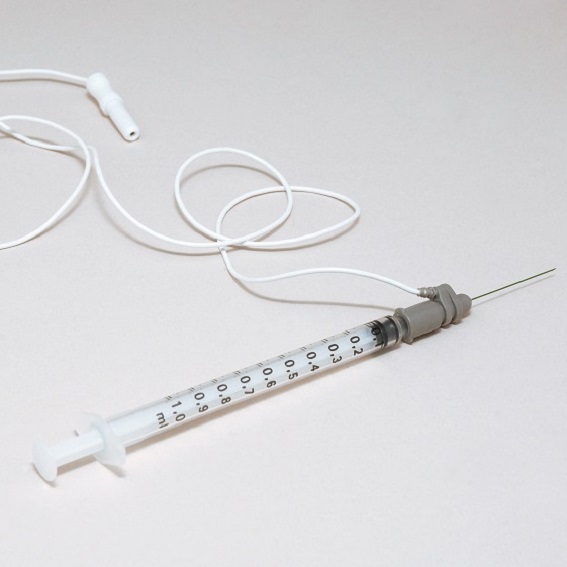There are several types of indwelling electrodes, of which needle electrodes are the most versatile: they occur as
- monopolar,
- bipolar concentric and
- single-fiber needle electrodes.

The monopolar needle electrode is a stainless steel needle fully insulated with a thin insulating coating except for the tip. Solid needles are used for diagnostic purposes; for EMG-guided injection of botulinum toxin, the needle is hollow. The recording area of this electrode is spherical. The reference electrode is placed at a myoelectric inactive location of the body and may be a surface electrode. For LEMG, a suitable place for the reference electrode is the skin over the manubrium sterni.

The concentric needle electrode consists of a hollow steel needle with a steel, silver, or platinum wire running through the needle, which is fully insulated except for the tip. The potential difference between the outer shaft of the needle and the tip of the wire is measured by connecting each of these to one port of the differential amplifier.
Since the electrode cannula acts as a shield, the electrode has directional recording characteristics controlled by the angle and position of the bevel. Therefore, a simple axial rotation of the electrode may significantly alter the individual motor units recorded.
The bipolar concentric electrode is sometimes called bifilar or double concentric. It is a hollow needle containing two platinum wires, each of which is insulated except for its tip. The outer shaft is grounded and the two internal wires are each connected to one side of the differential amplifier, so that the potential difference between the two wires is measured. The recording range of the bipolar concentric electrode is restricted to the area between the two tips of the wires within the shaft, which makes it unsatisfactory for many routine clinical purposes. The potentials are shorter and lower in the voltage than those recorded with concentric needle electrodes 1.
Comparing monopolar with concentric needle electrodes, potentials recorded by monopolar needle electrodes tend to be larger and longer with more phases than those recorded with concentric needle electrodes. This difference is based on the existence of more muscle fibers within the zone of detection, as well as on fewer cancellations due to potentials being recorded from the cannula of the electrode.
For single-fiber EMG (SFEMG), a fine wire capable of recording a single-muscle fiber action potential is embedded at the tip of the needle shaft acting as reference.
1 Guld C, Rosenfalck A, Willison RG (1970) Technical factors in recording electrical activity of muscle and nerve in man. Elec- troencephalogr Clin Neurophysiol 28(4): 399–413
